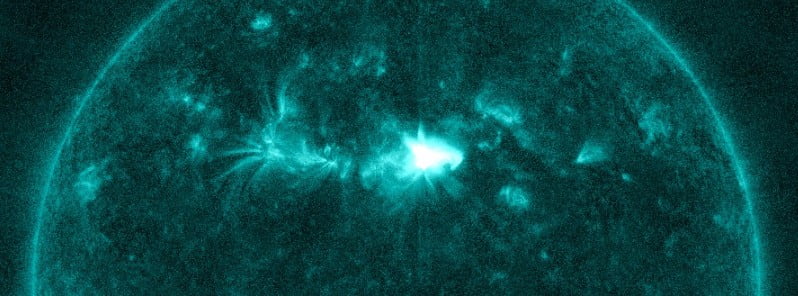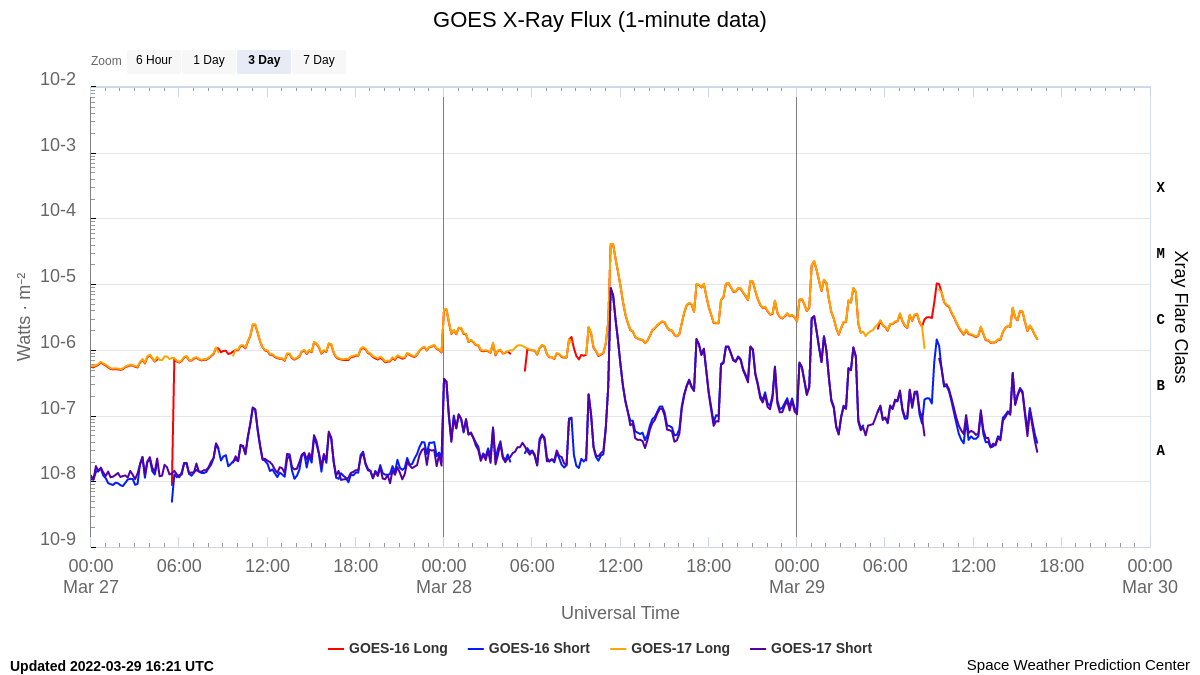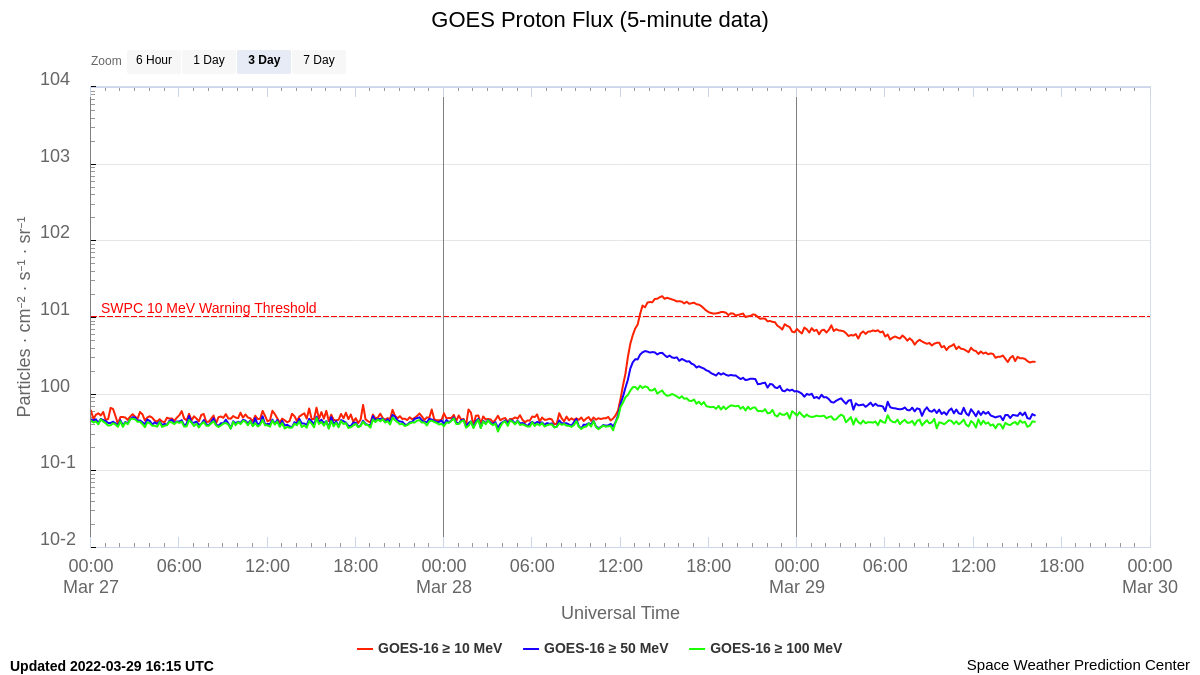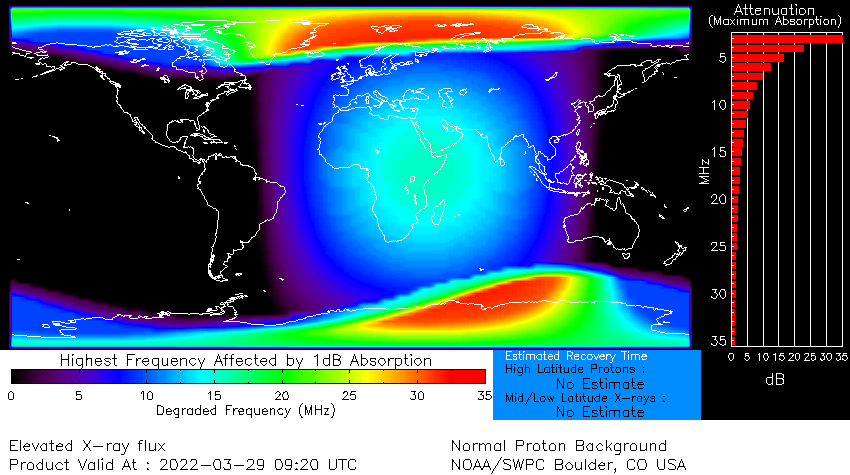Two CMEs heading toward Earth, G3 – Strong geomagnetic storm watch in effect

Active Region 2975 produced multiple C- and M-class solar flares since M4.0 at 11:29 UTC on March 28, 2022, as well as 2 coronal mass ejections (CMEs) – both toward Earth. As a result, a G3 – Strong geomagnetic storm watch is in effect for March 31.
Solar activity reached high levels in 24 hours to 12:30 UTC on March 29, with a total of 6 M1 or greater flares over the period. The strongest was M4.0 flare at 11:29 UTC produced by geoeffective Region 2975 (N13W18, Dsc/beta-gamma-delta).1

A type II Radio Emission was associated with the M4 flare with an estimated speed of 1 259 km/s and a subsequent partial halo/asymmetric full CME was observed in coronagraph imagery.
The greater than 2 MeV electron flux was at moderate levels during the period.
Shortly after the M4 event, the 10 and 100 MeV proton flux began to rise. The 10 MeV flux reached a peak of 18.7 pfu at 14:50 UTC on March 28 UTC and the 100 MeV flux peaked at 1.27 pfu at 13:25 UTC on March 28. Both radiation events ended shortly after and flux traces continue recovery toward the ambient background.

A second halo CME was observed in LASCO and STEREO data following a M1 flare at 19:23 UTC. A Type II Radio Emission was associated with this event too, with speeds estimated between 1 605 – 1 848 km/s.
This second CME also came from Region 2975 and appears as an asymmetric full halo in NASA SOHO LASCO C2/C3 and NASA STEREO B COR2.
Initial analysis and modeling indicated Earth-directed transients from both events with speeds of 667 km/s and 841 km/s respectively.
The second and faster CME is expected to catch up and combine with the first transient from the M4 event.
The combined arrival of both events at the magnetosphere protecting Earth is expected early March 31. Additional analysis and tweaking of the forecast is expected to continue throughout today, SWPC forecasters said.
“Forecast confidence of an Earth-directed component is moderate, while there is less confidence in timing and intensity. When the CME approaches Earth, NOAA’s DSCOVR satellite will detect the real-time solar wind changes and SWPC forecasters will issue any appropriate warnings. Impacts to technology from a G2 storm are generally small, but it can drive the aurora equatorward of its polar home. Aurora may be visible over the northern portions of the northern tier states if the conditions are favorable.”
“The blast from M4.0 flare propelled a ‘solar tsunami’ through the Sun’s atmosphere,” Dr. Tony Phillips of SpaceWeather.com said. “This tsunami was ‘radio-active.’ Its rippling leading-edge beamed radio waves toward Earth.”2

“I received a fantastic solar radio burst at 56 MHz,” said Rob Stammes who recorded the outburst at his space weather observatory in Lofoton, Norway. At about the same time, the US Air Force said they recorded both Type II and Type IV solar radio bursts.
“Energetic protons accelerated by the flare+tsunami peppered the Earth’s magnetosphere, causing an S1 – Minor radiation storm,” Phillips said, adding that our planet’s magnetic field funneled some of these particles toward the poles where the second type of radio blackout was underway – a Polar Cap Absorption Event. “Airplanes flying over these regions may find that their shortwave radios won’t work during the transit.”
A polar cap absorption (PCA) event results from the ionization of the D-layer of the polar ionosphere by high-energy protons. A PCA causes a HF radio blackout for trans polar circuits and can last several days. They are almost always preceded by a major solar flare with the time between the flare event and the onset of the PCA ranging from a few minutes to several hours.


Solar activity is expected to be low, with a chance for M-flares (R1-R2/Minor-Moderate), through March 31.
The greater than 2 MeV electron flux is likely to increase to moderate to high levels on March 29 and 30 due to high speed stream (HSS) influence. Normal to moderate 2 MeV electron flux levels are anticipated on March 31 due to associated effects with the arrival of the March 28 CMEs.
The greater than 10 MeV proton flux is expected to continue recovery from S1 – Minor levels through the rest of the day and then return to background-like levels with a slight chance for S1 – Minor levels on March 30 and 31.
Quiet to unsettled levels are expected through the rest of the day as HSS effects continue to gradually diminish followed by mostly quiet conditions on March 30.
A G2 – Moderate geomagnetic storming is likely to commence early March 31 with the arrival of Earth-directed components of the March 28 CMEs. It is expected to increase to G3 – Strong through the course of the day and return to G2 – Moderate levels on April 1.
***
Space Weather Message Code: WATA50
Serial Number: 67
Issue Time: 2022 Mar 29 1710 UTC
WATCH: Geomagnetic Storm Category G3 Predicted
Highest Storm Level Predicted by Day:
Mar 30: G1 (Minor) Mar 31: G3 (Strong) Apr 01: G2 (Moderate)
THIS SUPERSEDES ANY/ALL PRIOR WATCHES IN EFFECT
Potential Impacts: Area of impact primarily poleward of 50 degrees Geomagnetic Latitude.
Induced Currents – Power system voltage irregularities possible, false alarms may be triggered on some protection devices.
Spacecraft – Systems may experience surface charging; increased drag on low Earth-orbit satellites and orientation problems may occur.
Navigation – Intermittent satellite navigation (GPS) problems, including loss-of-lock and increased range error may occur.
Radio – HF (high frequency) radio may be intermittent.
Aurora – Aurora may be seen as low as Pennsylvania to Iowa to Oregon.
***
References:
1 Forecast Discussion Issued: 2022 Mar 29 1230 UTC – Prepared by the U.S. Dept. of Commerce, NOAA, Space Weather Prediction Center
2 SpaceWeather.com – March 28, 2022
Featured image credit: NASA/SDO, TW

Commenting rules and guidelines
We value the thoughts and opinions of our readers and welcome healthy discussions on our website. In order to maintain a respectful and positive community, we ask that all commenters follow these rules:
We reserve the right to remove any comments that violate these rules. By commenting on our website, you agree to abide by these guidelines. Thank you for helping to create a positive and welcoming environment for all.